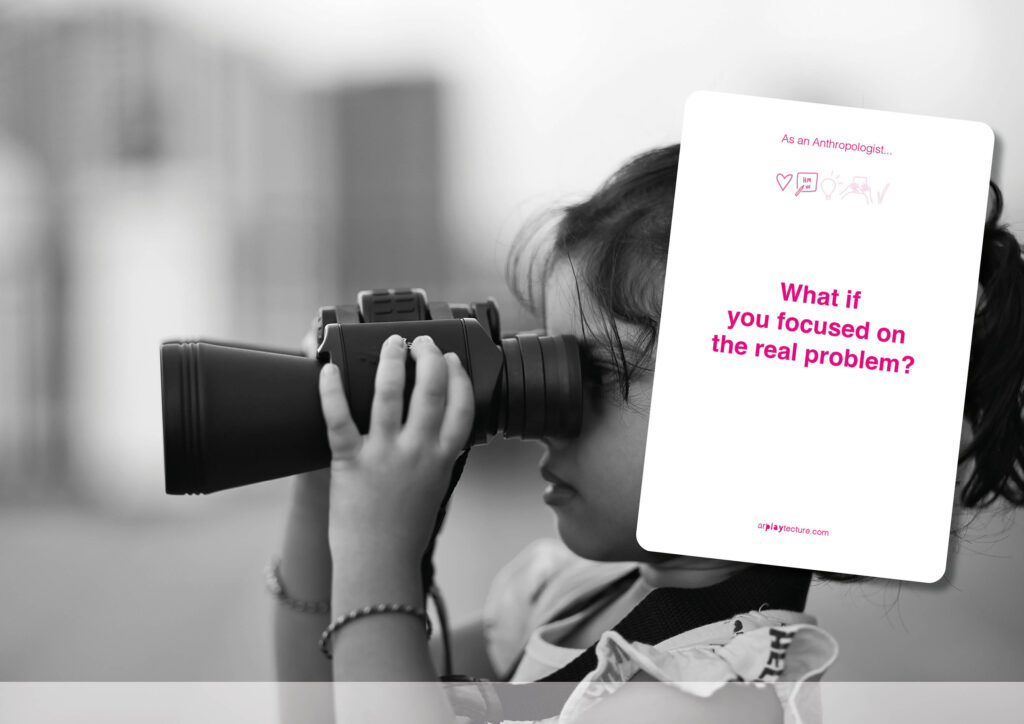Not every problem lies on the surface. Challenge Card 01 from the Arplaytecture deck urges us to look deeper:
The problem to solve does not always appear directly in front of your eyes. Dig deep under the surface to recognise the true challenge of offering innovative solutions.
As Kelley and Kelley remind us:
Sometimes, the first step toward a great solution is to reframe the question. Starting from a different point of view can help you get to the essence of a problem.1
By adopting the Anthropologist role, we embrace observation, empathy, and intuition to uncover the hidden core of a problem. With a beginner’s mindset and childlike curiosity, we immerse ourselves in users’ contexts to reveal the truths that fuel meaningful innovation.
We suggest using this card in the first stages of the design process: Empathise and define. Feel free to find new ways to use it!
Empathise: Observe with Fresh Eyes
Begin by stepping into the users’ world as if seeing it for the first time. Set aside assumptions and observe deeply, noticing both what is said and unsaid.
Be curious and attentive, like a child exploring their surroundings. Look for unusual habits and contradictions.
For example, if redesigning a public park, don’t rely solely on user surveys—observe how people engage with the space. You might find that shaded benches go unused, not because of the shade but because of uneven pathways leading to them.
Empathy requires immersing yourself in users’ realities, letting their stories unfold, and understanding the deeper context.
Define: Ask the Right Question
Once you’ve gathered insights, you can redefine the problem. The Anthropologist’s lens helps us dig beyond the obvious to uncover users’ actual needs.
Don’t settle for the obvious. Ask profound questions and challenge surface-level assumptions.
For example, if the challenge is to “improve park accessibility,” dig deeper and ask: Do physical barriers cause exclusion, or are cultural or emotional factors at play? Then, you can reframe the question: “How might we design a park that feels inclusive and welcoming to everyone?”
Reframing ensures solutions align with authentic user needs and desires, even those unspoken.
The Power of Digging Deeper
Challenge Card 01 invites us to embrace curiosity, empathy, and deep questioning to uncover the essence of problems. The Anthropologist role transforms problem-solving into meaning-discovery by asking:
Who are the people affected by the problem, and what are their stories?
What emotional and cultural factors shape their needs?
How can we design solutions that resonate deeply with their realities?
As Kelley and Kelley (2013) remind us, reframing questions leads to great solutions. The Anthropologist’s perspective reveals that digging deeper isn’t just about finding answers—it’s about uncovering meaning and potential. Henry Ford said,
If I had asked my clients what they wanted, they would have said a faster horse.
You know the rest of the story… True innovation stems from exploring beyond the surface. Trust your observations and intuition to uncover transformative solutions that redefine what’s possible by addressing the real, often hidden, challenges.
- Kelley, T., Kelley, D. (2013). Creative Confidence. Unleashing the creative potential within us. London: HarperCollins Publishers, p. 89. ↩︎

